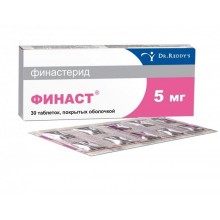



Pharmacodynamics
Finasteride is a 4-azasteroid compound that selectively and competitively inhibits 5α-reductase. This nicotinamide adenine dinucleotide phosphate (NADP) -dependent enzyme converts testosterone to dihydrotestosterone. The drug specifically inhibits isoenzyme 5α-reductase type 2, which leads to a significant decrease in dihydrotestosterone levels in the prostate gland (> 90%) and in the circulatory system (from 60% to 80%).
Finasteride increases testosterone levels in the prostate gland (approximately 85%) in patients with BPH, this does not affect the growth and morphology of the prostate gland. The drug has no pronounced affinity for androgen receptors. Finasteride significantly reduces plasma PSA levels by 41% - 71% in patients with symptoms of BPH. However, the drug does not affect the ratio of unbound and total PSA levels.
The size of the prostate gland decreases under the influence of finasteride due to atrophy and apoptosis. The histological changes caused by the drug effect were observed after 6 months from the start of treatment. The glandular elements of the prostate tissue are most sensitive to finasteride. The drug reduces the detrusor tone in patients with urinary retention caused by BPH.
Pharmacokinetics
Finasteride is well absorbed in the gastrointestinal tract, food slows down the rate of absorption, but does not affect the amount of absorption. The average bioavailability of finasteride is 63% (within 34 - 71%), based on the ratio of the area under the curve to the intravenous control dose. The maximum plasma concentration of finasteride is 37 ng / ml (27–49%) and is reached within 1–2 hours after administration. The drug accumulates in the body with repeated multiple injections. The establishment of an equilibrium concentration occurs after 17 days, the exact time is not known.
Approximately 90% of finasteride is circulating in a state bound to plasma proteins. The volume of distribution of finasteride is high (76 l in a stable condition); the drug penetrates the blood-brain barrier and a small amount is detected in the semen. The drug can be absorbed through the skin upon contact with crushed pills.
Finasteride is metabolized mainly by the liver to form inactive metabolites. Plasma clearance of finasteride 165 ml / min (70 -279ml / min) and a half-life of 6 hours. About 39% (32 - 46%) of the dose taken is excreted in the urine as metabolites and 57 (51 - 64%) through the intestine.
The pharmacokinetics of the drug as a whole does not change with an increase in the duration of renal failure. Pharmacokinetics of the drug in conditions of liver failure has not been studied.
1 coated tablet contains:
active substance: finasteride USP 5 mg,
Excipients: lactose, microcrystalline cellulose, sodium glycogen
glycolate, pregelatinized starch, sodium docus, magnesium stearate,
hypromellose, propylene glycol, titania dioxide, purified talc, dichloromethane,
isopropyl alcohol, titania dioxide
Finasteride is marketed under different brands and generic names, and comes in different dosage forms:
| Brand name | Manufacturer | Country | Dosage form |
|---|---|---|---|
| Finast | Dr. Reddy`s | India | pills |
| Penester | Zentiva KS | Czech | pills |
| Finasteride-Teva | Teva | Israel | pills |
| Finastiride | Obolensky OP | Russia | pills |
| Alfinale | Valenta | Russia | pills |
| Prosteride | Gedeon Richter | Hungary | pills |
| Proscar | Merck Sharp & Dohme | USA | pills |
No customer reviews for the moment.
Finast is taken orally, regardless of the meal - 5 mg 1 time per day. The duration of therapy to assess its effectiveness must be at least 6 months. In approximately 50% of patients, the disappearance of clinical symptoms occurs during treatment for 12 months.
Allergic reactions, gynecomastia, impotence, decreased libido, a decrease in the volume of ejaculate (the frequency of side effects does not exceed 3-4% and decreases during treatment). In some cases, there was an increase in the levels of LTG, FSH and testosterone by approximately 10% (however, these indicators remained within the normal range).
No clinically significant interaction of finasteride with other drugs was found.
Finasteride has no effect on cytochrome P450 - an enzyme system that provides the metabolism of drugs.
Simultaneous food intake reduces the absorption rate of finasteride, however, food does not affect the overall bioavailability.
Use in patients with impaired liver function
The effect on patients with impaired liver function has not been studied. Use with caution in patients with abnormal liver function, as finasteride is metabolized primarily by the liver.
Use in patients with impaired renal function
There is no need for individual dose selection in patients with impaired renal function.
Use during pregnancy and lactation
Finasteride is not indicated for pregnant and lactating women.
The impact on driving and other equipment has not been studied.
Before starting treatment with finasteride, it is necessary to conduct an appropriate examination to rule out other diseases similar in clinical practice to BPH, such as infections, prostate cancer, stricture, hypertensive bladder, or some neurogenic disorders. Patients with a large residual volume of urine and / or a decrease in the flow of urine should be kept under constant observation for possible obstructive uropathy when the appointment of finasteride is not indicated.
Women of childbearing age and pregnant women should avoid contact with crushed or damaged Finasteride pills because of the possibility of accumulation of Fynysteid in the body, with the consequent possible risk of fetal damage.
Lab tests
Finasteride is known to reduce the level of PSA (prostate-specific antigen) plasma in approximately 50% of patients with BPH, even in the presence of prostate cancer. A rapid decrease in PSA is observed in most patients during the first month of treatment, after which it stabilizes at a new level of approximately half the level recorded before the start of treatment. Therefore, when comparing these patients with healthy ones, PSA should be doubled. This adjustment allows us to take into account the sensitivity and specificity of the PSA assay and to diagnose prostate cancer.